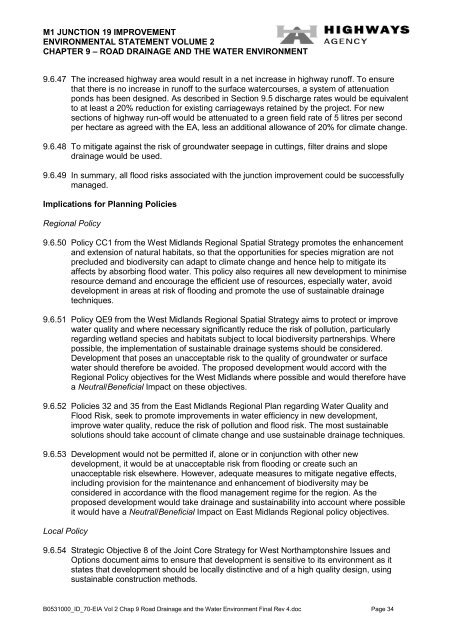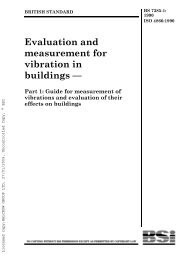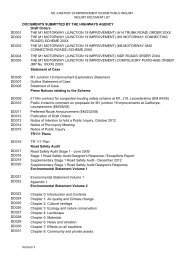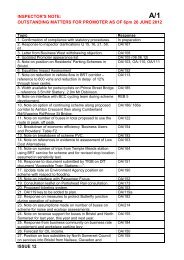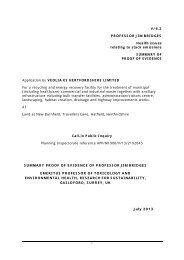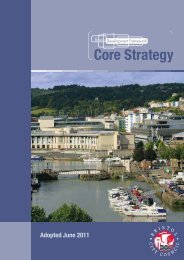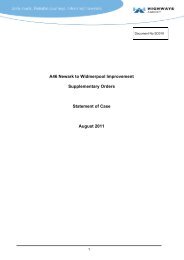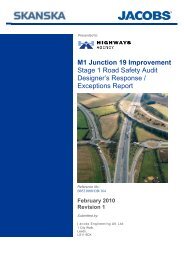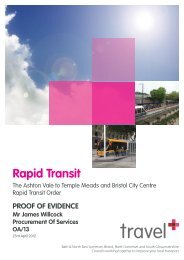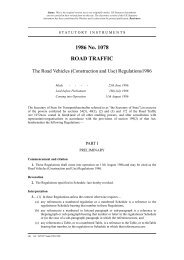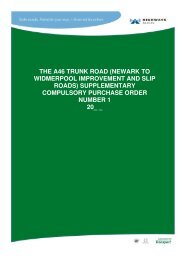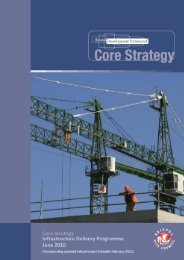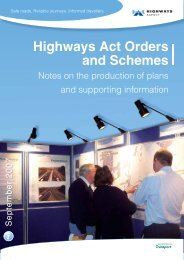Chapter 9: Road drainage and the water environment
Chapter 9: Road drainage and the water environment
Chapter 9: Road drainage and the water environment
You also want an ePaper? Increase the reach of your titles
YUMPU automatically turns print PDFs into web optimized ePapers that Google loves.
M1 JUNCTION 19 IMPROVEMENT<br />
ENVIRONMENTAL STATEMENT VOLUME 2<br />
CHAPTER 9 – ROAD DRAINAGE AND THE WATER ENVIRONMENT<br />
9.6.47 The increased highway area would result in a net increase in highway runoff. To ensure<br />
that <strong>the</strong>re is no increase in runoff to <strong>the</strong> surface <strong>water</strong>courses, a system of attenuation<br />
ponds has been designed. As described in Section 9.5 discharge rates would be equivalent<br />
to at least a 20% reduction for existing carriageways retained by <strong>the</strong> project. For new<br />
sections of highway run-off would be attenuated to a green field rate of 5 litres per second<br />
per hectare as agreed with <strong>the</strong> EA, less an additional allowance of 20% for climate change.<br />
9.6.48 To mitigate against <strong>the</strong> risk of ground<strong>water</strong> seepage in cuttings, filter drains <strong>and</strong> slope<br />
<strong>drainage</strong> would be used.<br />
9.6.49 In summary, all flood risks associated with <strong>the</strong> junction improvement could be successfully<br />
managed.<br />
Implications for Planning Policies<br />
Regional Policy<br />
9.6.50 Policy CC1 from <strong>the</strong> West Midl<strong>and</strong>s Regional Spatial Strategy promotes <strong>the</strong> enhancement<br />
<strong>and</strong> extension of natural habitats, so that <strong>the</strong> opportunities for species migration are not<br />
precluded <strong>and</strong> biodiversity can adapt to climate change <strong>and</strong> hence help to mitigate its<br />
affects by absorbing flood <strong>water</strong>. This policy also requires all new development to minimise<br />
resource dem<strong>and</strong> <strong>and</strong> encourage <strong>the</strong> efficient use of resources, especially <strong>water</strong>, avoid<br />
development in areas at risk of flooding <strong>and</strong> promote <strong>the</strong> use of sustainable <strong>drainage</strong><br />
techniques.<br />
9.6.51 Policy QE9 from <strong>the</strong> West Midl<strong>and</strong>s Regional Spatial Strategy aims to protect or improve<br />
<strong>water</strong> quality <strong>and</strong> where necessary significantly reduce <strong>the</strong> risk of pollution, particularly<br />
regarding wetl<strong>and</strong> species <strong>and</strong> habitats subject to local biodiversity partnerships. Where<br />
possible, <strong>the</strong> implementation of sustainable <strong>drainage</strong> systems should be considered.<br />
Development that poses an unacceptable risk to <strong>the</strong> quality of ground<strong>water</strong> or surface<br />
<strong>water</strong> should <strong>the</strong>refore be avoided. The proposed development would accord with <strong>the</strong><br />
Regional Policy objectives for <strong>the</strong> West Midl<strong>and</strong>s where possible <strong>and</strong> would <strong>the</strong>refore have<br />
a Neutral/Beneficial Impact on <strong>the</strong>se objectives.<br />
9.6.52 Policies 32 <strong>and</strong> 35 from <strong>the</strong> East Midl<strong>and</strong>s Regional Plan regarding Water Quality <strong>and</strong><br />
Flood Risk, seek to promote improvements in <strong>water</strong> efficiency in new development,<br />
improve <strong>water</strong> quality, reduce <strong>the</strong> risk of pollution <strong>and</strong> flood risk. The most sustainable<br />
solutions should take account of climate change <strong>and</strong> use sustainable <strong>drainage</strong> techniques.<br />
9.6.53 Development would not be permitted if, alone or in conjunction with o<strong>the</strong>r new<br />
development, it would be at unacceptable risk from flooding or create such an<br />
unacceptable risk elsewhere. However, adequate measures to mitigate negative effects,<br />
including provision for <strong>the</strong> maintenance <strong>and</strong> enhancement of biodiversity may be<br />
considered in accordance with <strong>the</strong> flood management regime for <strong>the</strong> region. As <strong>the</strong><br />
proposed development would take <strong>drainage</strong> <strong>and</strong> sustainability into account where possible<br />
it would have a Neutral/Beneficial Impact on East Midl<strong>and</strong>s Regional policy objectives.<br />
Local Policy<br />
9.6.54 Strategic Objective 8 of <strong>the</strong> Joint Core Strategy for West Northamptonshire Issues <strong>and</strong><br />
Options document aims to ensure that development is sensitive to its <strong>environment</strong> as it<br />
states that development should be locally distinctive <strong>and</strong> of a high quality design, using<br />
sustainable construction methods.<br />
B0531000_ID_70-EIA Vol 2 Chap 9 <strong>Road</strong> Drainage <strong>and</strong> <strong>the</strong> Water Environment Final Rev 4.doc Page 34


